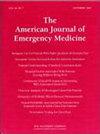成年脑外伤患者的抗癫痫药物治疗方法。
IF 2.7
3区 医学
Q1 EMERGENCY MEDICINE
引用次数: 0
摘要
背景:在创伤性脑损伤(TBI)中使用抗癫痫药物(ASM)可降低早期创伤后癫痫发作(PTS)的风险。美国各创伤中心的药剂选择和剂量策略仍不一致:本研究旨在确定和描述美国各地成人创伤中心对脑损伤患者最常用的 PTS 预防方案:方法: 2023 年 3 月,我们制作并分发了一份调查表,评估创伤中心的 PTS 预防方法。然后根据实践地点的人口统计学特征和各种分组分析(包括学术中心与非学术中心、创伤中心的指定、实践地点的地理位置和每年 TBI 激活的总次数)对数据进行评估:共有 84 个不同的创伤中心做出了回复,其中 82 个(97.6%)回复者称左乙拉西坦(LEV)是其预防创伤后应激障碍的首选 ASM。报告最多的给药方案包括初始剂量 1000 毫克(24 人,占 46.2%),然后是维持剂量 500 毫克,每日两次(39 人,占 48.8%)。在所评估的分组分析中,各组之间的做法没有明显的统计学差异:有趣的是,绝大多数创伤中心并不遵守脑外伤基金会的指导方针,而是将 LEV 作为首选药物。进一步的研究应评估 PTS 预防的理想患者选择、最佳药剂和剂量方案。本文章由计算机程序翻译,如有差异,请以英文原文为准。
Antiseizure medication practices in the adult traumatic brain injury patient population
Background
Antiseizure medication (ASM) use in traumatic brain injuries (TBI) reduces the risk of early post-traumatic seizure (PTS). Agent selection and dosing strategies remain inconsistent among trauma centers in the United States.
Objective
The purpose of this study was to identify and characterize the most common PTS prophylaxis regimens among adult trauma centers in brain injured patients throughout the United States.
Methods
A survey assessing PTS prophylaxis practices of trauma centers was created and distributed in March 2023. Data was then evaluated based on practice site demographics and various sub-group analyses including academic vs. non-academic centers, trauma center designation, geographic practice location, and total number of TBI activations annually.
Results
A total of 84 different trauma centers responded of which, 82 (97.6 %) respondents reporting levetiracetam (LEV) as their ASM of choice for PTS prophylaxis. The most reported dosing regimen included an initial dose of 1000 mg (n = 24, 46.2 %) followed by a maintenance dose of 500 mg BID (n = 39, 48.8 %). There were no statistically significant differences in practice between sub-group analyses evaluated.
Conclusion and relevance
This multicenter, survey study, identified variances in practice for PTS prophylaxis for brain injured patients throughout the U.S. Interestingly, the overwhelming majority of trauma centers do not conform to the Brain Trauma Foundation guidelines and utilize LEV as their agent of choice. Further studies should evaluate ideal patient selection for PTS prophylaxis, optimal agent, and dosing schemes within this cohort.
求助全文
通过发布文献求助,成功后即可免费获取论文全文。
去求助
来源期刊
CiteScore
6.00
自引率
5.60%
发文量
730
审稿时长
42 days
期刊介绍:
A distinctive blend of practicality and scholarliness makes the American Journal of Emergency Medicine a key source for information on emergency medical care. Covering all activities concerned with emergency medicine, it is the journal to turn to for information to help increase the ability to understand, recognize and treat emergency conditions. Issues contain clinical articles, case reports, review articles, editorials, international notes, book reviews and more.

 求助内容:
求助内容: 应助结果提醒方式:
应助结果提醒方式:


